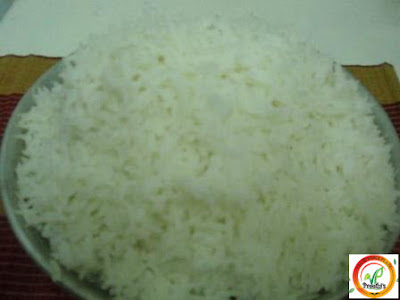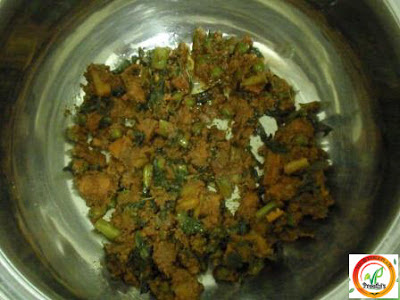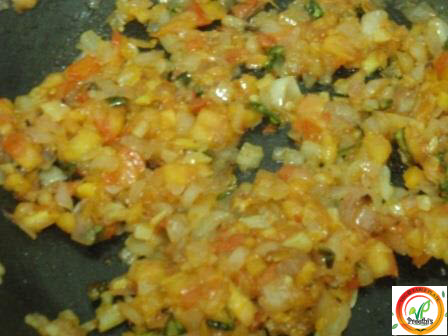Peanut-onion kozhambu is a variation from your normal kozhambu's. It is made with boiled peanut and onion and some fresh ground powder & coconut milk mixed in tamarind water. This is easy to make and requires no dhal in its preparation. It can be had with any side-dish, preferably any roast dish to enjoy it. Peanuts are packed with immense health benefits. Boiled peanut make up a good snack for the evening for everyone, right from children to adults. This kozhambu is not only tasty, but gives good health benefits too.
Health Benefits of Peanuts:
1. Peanuts are good source of protein.
2. Peanuts have cardio-protective and cancer-preventive properties.
3. Rich in some minerals like Magnesium, copper, zinc and selenium.
4. It contains Vitamin-B, folate and Vitamin-E.
5. Peanuts are plant food and contain no cholestrol.
6. Peanuts have low Glycaemic Index.
Ingredients:
Peanut (boiled) - 1/2 Cup
Small onions (peeled) - 1/2 Cup
Tamarind extracted water - 2 Cup
Instant ground powder - 3 to 4 tsp
Salt - 2 tsp
Oil - 4 tsp
Turmeric powder - 1/2 tsp
Hing - 1/2 tsp
Coconut milk - 1/2 Cup (thick milk)
Seasoning Ingredients: oil - 1 tsp, mustard - 1 tsp, broken urud dhal - 1 tsp, channa dhal - 1 tsp, curry leaves - 5, hing - 1/2 tsp
Pre-requisite:
1. Boil peanuts for 3-4 whistles and keep ready.
2. In a teaspoon of oil, fry the below and prepare the Instant ground powder and keep ready.
- Whole coriander seeds - 1 1/2 tsp, Channa Dhal - 1 1/2 tsp, Whole black pepper - 3/4 tsp, Red chillies - 6, . Fenugreek - 1/2 tsp, Curry leaves - 10, hing - 1/2 tsp
3. Extract half a cup of thick coconut milk and keep ready.
Method:
1. In a kadai/non-stick pan, add oil and saute the onions till they're translucent.
2. Add the boiled peanuts and fry for few minutes. Then add turmeric powder, hing and salt.
3. Add the tamarind extracted water and boil until the raw smell of the tamarind leaves and the tamarind water is reduced to half its quantity.
4. Add the Instant ground powder and mix well and boil for another 2-3 minutes.
5. When the Kozhambu has reached your desired consistency (thick consistency), add the coconut milk. Once the coconut milk is added, don't boil for too long, just 2-3 minutes of boiling is enough.
6. Season as given and pour onto the kozhambu and serve.
Health Benefits of Peanuts:
1. Peanuts are good source of protein.
2. Peanuts have cardio-protective and cancer-preventive properties.
3. Rich in some minerals like Magnesium, copper, zinc and selenium.
4. It contains Vitamin-B, folate and Vitamin-E.
5. Peanuts are plant food and contain no cholestrol.
6. Peanuts have low Glycaemic Index.
Ingredients:
Peanut (boiled) - 1/2 Cup
Small onions (peeled) - 1/2 Cup
Tamarind extracted water - 2 Cup
Instant ground powder - 3 to 4 tsp
Salt - 2 tsp
Oil - 4 tsp
Turmeric powder - 1/2 tsp
Hing - 1/2 tsp
Coconut milk - 1/2 Cup (thick milk)
Seasoning Ingredients: oil - 1 tsp, mustard - 1 tsp, broken urud dhal - 1 tsp, channa dhal - 1 tsp, curry leaves - 5, hing - 1/2 tsp
Pre-requisite:
1. Boil peanuts for 3-4 whistles and keep ready.
2. In a teaspoon of oil, fry the below and prepare the Instant ground powder and keep ready.
- Whole coriander seeds - 1 1/2 tsp, Channa Dhal - 1 1/2 tsp, Whole black pepper - 3/4 tsp, Red chillies - 6, . Fenugreek - 1/2 tsp, Curry leaves - 10, hing - 1/2 tsp
3. Extract half a cup of thick coconut milk and keep ready.
Method:
1. In a kadai/non-stick pan, add oil and saute the onions till they're translucent.
2. Add the boiled peanuts and fry for few minutes. Then add turmeric powder, hing and salt.
3. Add the tamarind extracted water and boil until the raw smell of the tamarind leaves and the tamarind water is reduced to half its quantity.
4. Add the Instant ground powder and mix well and boil for another 2-3 minutes.
5. When the Kozhambu has reached your desired consistency (thick consistency), add the coconut milk. Once the coconut milk is added, don't boil for too long, just 2-3 minutes of boiling is enough.
6. Season as given and pour onto the kozhambu and serve.
























































